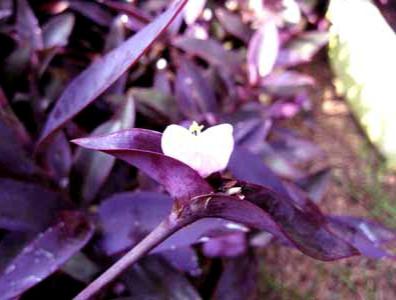By Tommy Clarkson from the November 2012 Edition

Tradescantia pallida Family: Commelinaceae
Also known as Purple Queen or Wandering Jew
(To those with whom I served, worked and wearied, in VietNam and Iraq, who incurred injuries or gave that final great measure of life during the course of those hostilities, and who so very correctly were awarded the military award of this plant’s name, I dedicate this column.)
Now there are no few plants purported to have purple foliage. But this long-jointed, sprawling groundcover is really purple! Originating in Eastern Mexico – reaching England around 1600 its Latin name is derived via an honor bestowed upon the famous naturalist, John Tradescant.
Attractive, hardy and well rooted like my Patty this tenacious, trailing, evergreen, perennial plant seems to best like a rich moist soil for its roots; has the richest colors and grows most vigorously in the full sun; and, prefers ample, regular watering – but will forgive you if you’re occasionally a bit late with that chore! It is low growing not much more than a foot or so high and when grown outdoors, insects are seldom a problem.
It is not a big fan nor advocate of the cold. But in our environs the Purple Heart is an excellent landscaping plant, can be grown indoors, used in hanging baskets or planted as a container plant (but appreciates regular fertilization in this mode). It blooms constantly during warm weather.
On its succulent stems are nice looking, spear shaped leaves of about 2.5 cm (1”) wide and 7.6 to 12.7 cm (3-5”) long. (Note for awareness: The stems are quite fragile and will break off rather easily if bumped.)
As mentioned earlier, the stems and upper surfaces of the leaves are a deep royal purple. As the foliage matures, these become suffused with a faint dusty turquoise-gunmetal undertone.

The undersides of the leaves are yet more vivid in a violet shading, leaning towards pink where the petioles encircle the stem. Small, pale white, pink or purple, three-petaled flowers emerge from curving double bracts at the stem tips and bloom but one day. However, go out to your garden early in the morning to see these delicate little flowers as that is the only time that they are open.
Now, before proceeding any further, a warning word to the wise . . . and even the not so wise! This attractive plant can be quite invasive and exceedingly persistent in its homesteading! As one of the writers correctly described, in a note posted on the “Dave’s Garden” web site, “It will easily take over areas and grow out of hand. Getting rid of it in an area can be difficult as you have to clean out all of the roots… and there are a lot.” This, for some, is its foremost shortcoming.
Want to give a friend a start from your plant, or transplant some of yours elsewhere? That’s easy with this tough, but attractive, plant. Using a little dirt, just cover part of a stem with an attached leaf node and it will root. Keep the soil moist until it is growing, healthy and strong.
I’ve heard of contact dermatitis supposedly occurring for some during maintenance pruning when the cut leaf and stem sap touches and dries on bare skin but it’s never bothered me. On the positive side, I’ve read (but can not confirm) that through a process known as phytoremediation, Tradescantia pallida “has been judged exceptionally effective at improving indoor air quality by filtering out volatile organic compounds, a class of common pollutants and respiratory irritants.”
If you come to like this plant, some of Purple Heart’s close Spiderwort kin are the green (also called) Wandering Jew (T. fluminensis) and the purple (same same) Wandering Jew (T. ZEBRINA).

The small, pretty flowers appear only in the mornings and then for just one day.

Download the full edition or view it online
—
Tommy Clarkson is a bit of a renaissance man. He’s lived and worked in locales as disparate as the 1.2 square mile island of Kwajalein to war-torn Iraq, from aboard he and Patty’s boat berthed out of Sea Bright, NJ to Thailand, Germany, Hawaii and Viet Nam; He’s taught classes and courses on creative writing and mass communications from the elementary grades to graduate level; He’s spoken to a wide array of meetings, conferences and assemblages on topics as varied as Buddhism, strategic marketing and tropical plants; In the latter category he and Patty’s recently book, “The Civilized Jungle” – written for the lay gardener – has been heralded as “the best tropical plant book in the last ten years”; And, according to Trip Advisor, their spectacular tropical creation – Ola Brisa Gardens – is the “Number One Tour destination in Manzanillo”.





You must be logged in to post a comment.